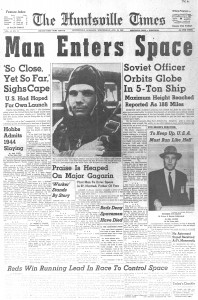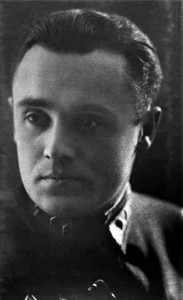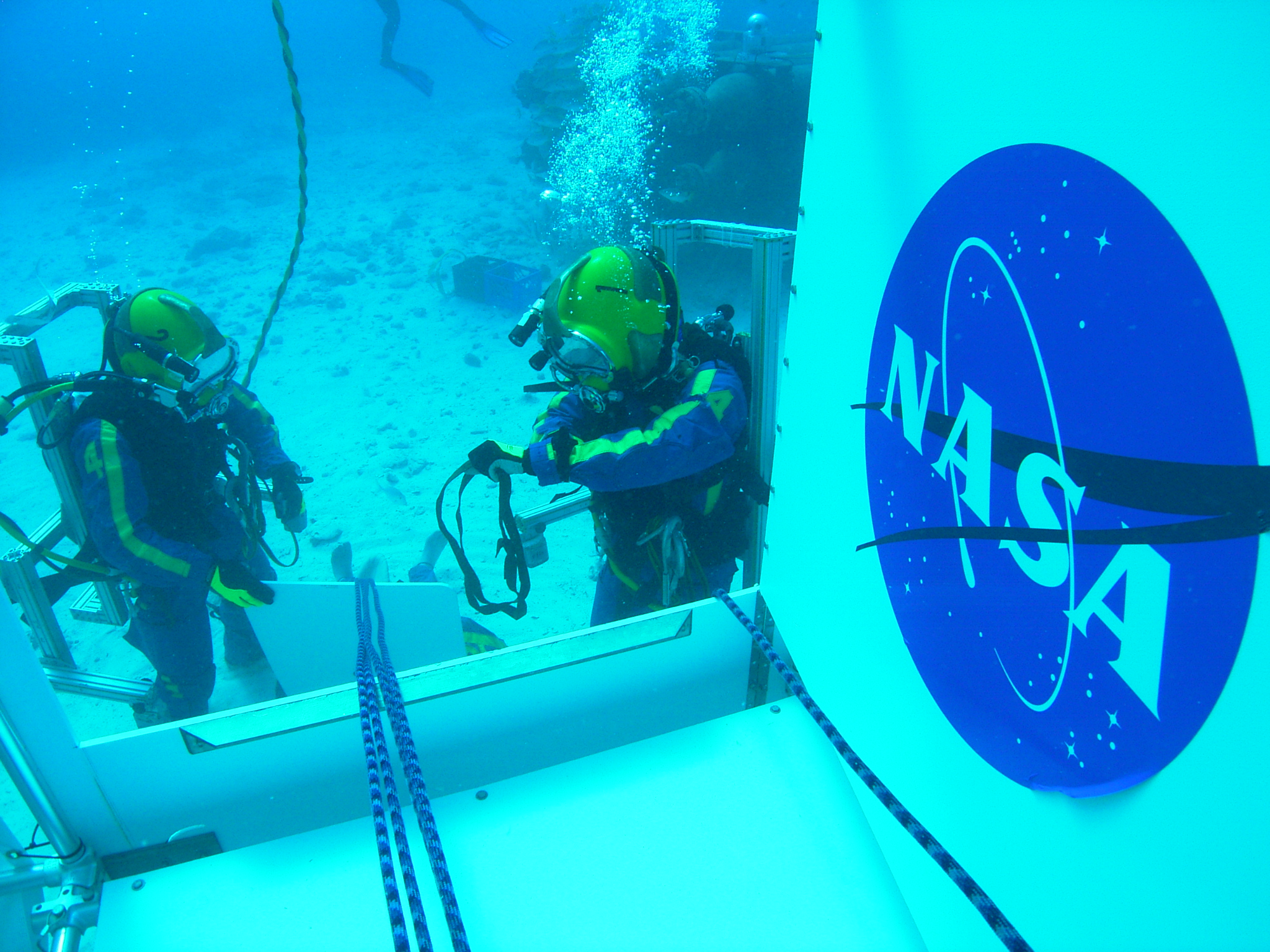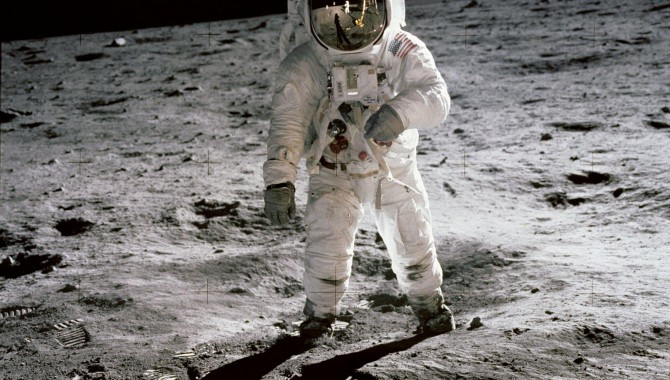
By Piers Bizony
During the space race of the 1960s, NASA Administrator James Webb and his Soviet counterpart, Sergei Korolev, shared the determination and skill needed to push a rocket program past countless political barriers, beyond the reach of jealous rivals, and toward success. Surprisingly, though, it was the American leader who exerted the kind of central control we typically associate with the Soviets.
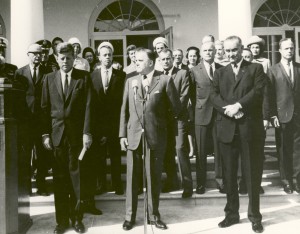
NASA Administrator James E. Webb (center) cites the space achievements of the Project Mercury astronauts who received the 1963 Collier Trophy Award in a ceremony held at the White House on October 10, 1963. President John F. Kennedy (left) and Vice President Lyndon Johnson accompanied Webb at the ceremony.
Photo Credit: NASA
In the proud Soviet announcements about Yuri Gagarin’s historic ride into space, the man who sent him up there was not allowed to share any of the public glory. Born in 1907 in Ukraine to Russian parents, and educated in Kiev and Moscow, Sergei Pavlovich Korolev began his career as an aircraft designer. At first he saw rockets as a useful power source for aircraft, but by the late 1930s he knew they could be vehicles in their own right.
The Soviet military showed a keen interest in rockets. In 1933 Marshal Mikhail Tukhachevsky sponsored a research center, the Gas Dynamics Laboratory, hidden away behind the ramparts of the Petrapavlovskaya Fortress in St. Petersburg, known at that time as Leningrad. Another facility in Moscow, the Reaction Propulsion Laboratory, worked along similar lines. From the union of these two efforts, Valentin Glushko emerged as the most promising designer of combustion chambers and fuel pumps, while Korolev thought in broader terms about rockets.
Unfortunately, Joseph Stalin was terrified of intelligent soldiers, and in 1937 he began a purge of the officer class. All the rocket engineers that the military had sponsored came under suspicion, and by June the following year they were in custody and suffering various extremes of coercion and torture. Korolev was dragged away on June 27, 1938, and condemned to ten years in a Siberian gulag. Glushko seems to have escaped the camps by denouncing Korolev. The sequence of events is uncertain, but one thing is for sure: throughout their subsequent alliance on some of the greatest pioneering achievements in rocketry, the two men loathed each other.
Fortunately for Korolev, the aircraft designer Andrei Tupolev, also a political suspect, was head of a “sharashka” in Moscow, a research facility within the prison camp system where valued prisoners could work on engineering projects in relative comfort. At Tupolev’s request, Korolev joined his team. A telling detail of Soviet leniency was the fact that Korolev was released from the Siberian camp and ordered to report to Moscow, but no transport was made available to him. His improvised return journey, on foot, by ship, and by hitching rides on trucks, took many weeks and nearly killed him.
According to Yuri Mazzhorin, one of Korolev’s senior experts on guidance trajectories, “He was an extraordinary person. You’d think his time in prison would have broken his spirit, but to the contrary, when I first met him in Germany when we were investigating the V2 weapons, he was a strong-willed, purposeful person who knew exactly what he wanted. But he never insulted you. He would always listen to what you had to say. Everybody loved him.”
Korolev’s greatest creation was the R-7 missile, or Semyorka, “Little Seven” as it was affectionately known by the men who built it or flew on it. Fueled with liquid oxygen and kerosene, and incorporating four drop-away boosters parallel to a central core, this was the world’s first intercontinental ballistic missile. Glushko’s compact turbine fuel pumps and pipework serviced four combustion chambers simultaneously. The thrust of twenty separate nozzles was distributed among just five engine assemblies. The first launches of the R-7 failed, but on August 3, 1957, it flew a simulated nuclear strike mission (over Soviet territory), then began its career as a space launcher on October 4 that year, launching Sputnik, the world’s first artificial satellite.
Dr. Andy Aldrin, director of business development and advanced programs for United Launch Alliance, and also a keen space historian, admires the speed with which Korolev could conjure up space triumphs. “He tried to go on vacation after Sputnik, and he got a call from Khruschev. ‘Comrade, come to the Kremlin.’ Of course he went, and Khruschev said, ‘In a month we have the fortieth anniversary of the glorious October Socialist Revolution. We want you to put up another satellite that will do something important.’ He wanted a satellite that could broadcast the ‘Communist Internationale’ from space, but Korolev had another idea. He wanted to launch a living creature. And within a month, he and his people scratch-built a special capsule and did just that.”
Sputnik II went up on November 3, 1957, carrying the dog Laika, a living, breathing mammalian creature. This was a clear indication where Korolev was heading. Dr. Aldrin takes up the story. “Korolev promised the military that he could build spy satellites, and then said, ‘Of course we have to develop manned capsules first, so that trained pilots with good eyesight can report on what the cameras are likely to see.’ Basically, he conned them. He really understood how to work the political system.”
Unfortunately, command over Russian space affairs became increasingly less well defined throughout the 1960s. While Korolev won political backing for his R-7 programs by virtue of his successes, this didn’t mean that he had much authority over his competitors, Vladimir Chelomei, mastermind of the Proton rocket; Glushko, the ever-resentful engine designer; and Mikhail Yangel, yet another missile tsar working out of Ukraine. The late-1960s Soviet effort to send a cosmonaut to the moon was not actually one effort but several, all viciously competing for funds and patronage. Korolev’s death from cancer in 1966 allowed his rivals to wreak havoc unchecked. Russia’s lunar ambitions decayed into a terrible mess, culminating in disastrous launch explosions and a costly lack of focus.
Strangely enough, NASA’s Apollo project was a success because its leadership under Webb and his close deputies, Robert Seamans and George Mueller, was somewhat Sovietist in its nature: collective at ground level, but with tightly centralized and sometimes ruthless control from this small cadre within Washington Headquarters. One instance involved Harry Goett, the successful, hard-driving head of the Goddard field center in the early 1960s. Webb freely admitted that Goett had achieved an excellent record, but “he thought he was so good that he could get away with it—that, by God, nobody could really cause him any serious trouble. He said he wanted to draw an absolute line between the people that worked for him, and those that were in Headquarters.” Goett was eased out of his post.
Strangely enough, NASA’s Apollo project was a success because its leadership under Webb and his close deputies, Robert Seamans and George Mueller, was somewhat Sovietist in its nature …
In 1963, an alarmed U.S. senator, William Proxmire, said that “NASA is probably the most centralized government-spending program in the United States. It concentrates in the hands of a single agency full authority over an important sector of the economy. This could be described as corporate socialism.” NASA’s Apollo-era chief, Webb, was feared by many prominent Americans precisely for those reasons, but his firm grasp on the reins was crucial to Apollo’s success.
It enabled the agency to achieve great success and prestige throughout the Mercury and Gemini programs, because of his insistence that all NASA field centers should be answerable to the needs of specific space programs, and not the other way around. Not everyone liked it, but Webb’s imposed unity was valuable throughout most of the 1960s. The International Space Station is a great success today, but arguments among NASA centers before the first metal was cut lost time and cost the United States a great deal of money. Webb would never have stood for that lack of unity.
The Soviet lunar programs faltered because their power structures were not hierarchical and decisive but individualistic and quarrelsome. Korolev and his rivals were rather like nineteenth-century American railroad barons ruthlessly trying to shoulder each other out of the way, each determined to see their train, rather than the other fellow’s, play the leading role. None of them seemed quite strong enough to take overall charge of Russia’s space effort, while the Kremlin failed miserably to impose unity under one office.
The real test of Webb’s strength of character came in the wake of the Apollo 1 fire of January 1967. He shouldered much of the blame during the subsequent Congressional inquisitions, protecting Apollo and its people as best he could from direct repercussions. His fury at some senior NASA colleagues was not because of the fire itself; they had failed to warn him about contractual problems with Apollo’s manufacturers. Congress knew about these, and tried to use them to tarnish Webb’s personal reputation.
People often think that “money was no object for Apollo.” Nothing could be further from the truth. The political mood in 1967 was very different from in 1961, when the program had been initiated. Webb had to fight exceptionally hard to protect Apollo, especially given the fact that none of the new lunar vehicles had even left the ground at the time of the fire.
Webb may not have suffered such extreme physical cruelties as Korolev suffered, but by the standards of bureaucratic life in the United States, he also had to show extraordinary courage—in defense of NASA, its people, and its programs. Time and again he supported the judgment of colleagues within the agency against political interference. In his own words, he “couldn’t let anybody dictate the decisions that were at the technical level, whether it was the president or the vice president or the scientists.”
Today Webb is revered, but just as Korolev was accused of sabotage and disloyalty, and then had to spend more than a decade clearing his name, so the U.S. political establishment took just as many years to “exonerate” Webb from blame with regard to the Apollo 1 fire, and to remove once and for all the subtle accusations of dishonesty leveled against him during the Congressional inquiries and accompanying media assaults on his good name. Even a decade after the triumph of Apollo 11, the much-respected Republican Senator Margaret Chase Smith felt the need to lodge a formal letter with Congress, expressing her “disappointment at the lack of recognition for the man who put a man on the moon, James E. Webb. He had to take the heat and fire of partisan political attacks from headline-hungry politicians. I saw this at firsthand in my work on the Senate Space Committee. But as compared to the hero astronauts, what recognition or material gains did Jim Webb, and the thousands behind the scenes he typified, receive? Minimal, if any. They declined to commercially exploit their official positions. And today, they are forgotten men and women.”
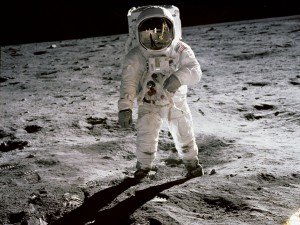
Astronaut Edwin “Buzz” Aldrin walks on the moon during the Apollo 11 mission. Photo Credit: NASA/Neil Armstrong
Korolev similarly gets too little of the glory for humankind’s earliest space triumphs. Alexei Leonov, the first man to walk in space, described to this author a tragic last meeting shortly before Korolev’s death on January 14, 1966, when a surgical procedure for stomach ulcers revealed serious cancers and internal bleeding. Throughout all his years working to give the Soviets a lead in space, Korolev seldom discussed his arrest, torture, beatings, and imprisonment under the old Stalinist regime. People thought of him as a burly man built like a bear, yet the truth was that his body was made rigid by countless ancient injuries. Leonov described a man who “couldn’t turn his neck but had to swivel his upper torso to look people in the eye, and nor could he open his jaws wide enough to laugh out loud.”
Two days before he was scheduled for surgery, Korolev was resting at his home in Moscow. Gagarin and Leonov came to visit him with several other friends, and at the end of the evening, just as most of the visitors were putting on their greatcoats to leave, Korolev said to his two favorite cosmonauts, “Don’t go just yet. I want to talk.” According to Leonov, “He told us how he was taken away and beaten. When he asked for a glass of water they smashed him in the face with the water jug. They demanded a list of so-called traitors in the rocket laboratories, and he could only reply that he had no such list. Then they sent him to the prison camp.”
This great powerhouse of a man had never spoken before in such a fragile and personal way, and the two young cosmonauts were deeply affected by what they heard. Leonov told me, “This was the first time that he had ever talked about his imprisonment in the gulag, since these stories are usually kept secret. We began to realize there was something wrong with our country. On our way home, Yuri couldn’t stop questioning. How could it be that such unique people like Korolev had been subjected to repression? It was so obvious that he was a national treasure.” Webb was also a “national treasure,” but the strange fact is most Americans have never heard of him.
About the Author
 |
Piers Bizony has written about science, aerospace, and cosmology for a wide variety of magazines in the United Kingdom and the United States. 2001:Filming the Future, his award-winning book on the making of Stanley Kubricks 2001: A Space Odyssey, has become a standard reference work. It was also the basis for a C4 documentary film. In 1997, The Rivers of Mars, his critically acclaimed analysis of the life-on-Mars debate, was short-listed for the NASA/Eugene M. Emme Award for Astronautical Writing, while Starman, produced as an acclaimed book and a BBC film, told the story of Soviet cosmonaut Yuri Gagarins life for the first time. |
More Articles by Piers Bizony
- Apollo Technology: Back to the Future (ASK 36)
- Viewpoint: The Bigger Pictures (ASK 33)






